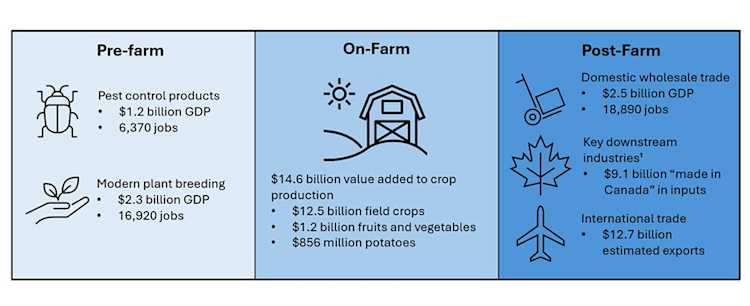Cultivating prosperity: How plant science innovations are driving Canada’s agricultural success

Canadian agriculture has been a driving force in global agricultural productivity growth for decades, thanks to plant science innovations. A recent report offers insights into the value that plant science innovations have had for Canada’s agriculture sector and the greater Canadian economy. Here are some key findings from the report, which is available in full here.
Economic benefits of plant science innovations
Figure 1: Value of Plant Science Innovations to Canadians in 2023 – Pre-Farm, On-Farm, and Post-Farm

1These downstream industries include grain and oilseed milling, other food manufacturing, animal production, and basic chemical manufacturing (mostly ethanol).
Sources: RAIS, FCC
The value added of plant science innovations in Canada has been substantial. In their report, Regulatory Impact Alternatives Strategies (RIAS) estimates the following pre-farm, on-farm, and post-farm economic benefits of plant science innovations in 2023.
Pre-farm, crop protection and modern plant breeding sectors contributed over $3.5 billion in GDP and more than 23,000 jobs to the Canadian economy.
On-farm, crop science innovations supported $14.6 billion dollars in farmgate revenues.
Post-farm, these innovations added $2.5 billion to Canadian wholesale trade GDP and generated close to 19,000 wholesale jobs. They contributed an estimated $9.1 billion in inputs to key domestic industries downstream of crop production – like grain and oilseed milling, and animal production. And they had a substantial impact on Canada’s trade position, generating an estimated $6.4 billion in export value (approximately 30% of Canada’s net agriculture product trade balance that year).
Canadian consumers have also benefited from plant science innovations through lower food costs. In the absence of plant science innovations, Canadian consumers would be paying a much higher price for their food: at least 25% more than they pay now, and perhaps as much as 65% over the average food bill of a consumer. This would have devastating impacts on food security and nutritional outcomes for Canadian households.
More innovation is needed to meet productivity goals
In recent years, productivity growth in Canadian agriculture has stagnated, raising concerns about our ability to maintain our leadership position within the global food system, and to meet future challenges and rising food demand. Crop productivity growth peaked in the 2000s, with an average annual growth rate of 2.9% in that decade. Since then, average annual crop productivity growth has been on the decline. The status quo would lead to a decline not recorded since the 1980s.
Rekindling productivity growth to peak levels seen in the past will contribute significantly to capturing the $30 billion opportunity for Canada’s agriculture sector. Plant science innovations have played a pivotal role in driving past productivity growth and improving the profitability of Canadian crop production. If we want to seize this opportunity, we need to boost the momentum of plant science innovation. Here are some key recommendations.
Foster an inviting business environment to innovations
Integrate regulatory efficiency into economic growth objectives
Make innovation, productivity, and competitiveness a top priority
Looking ahead, the potential for future growth in Canada’s crop production sector is immense. By developing and embracing new plant science innovations, and fostering a culture of continuous improvement, we can enhance productivity, sustain economic growth, and ensure food security for future generations. Together we can cultivate a future where Canadian agriculture thrives as a beacon of innovation and productivity within the global food system.
Article by: Bethany Lipka, Business Intelligence Analyst
